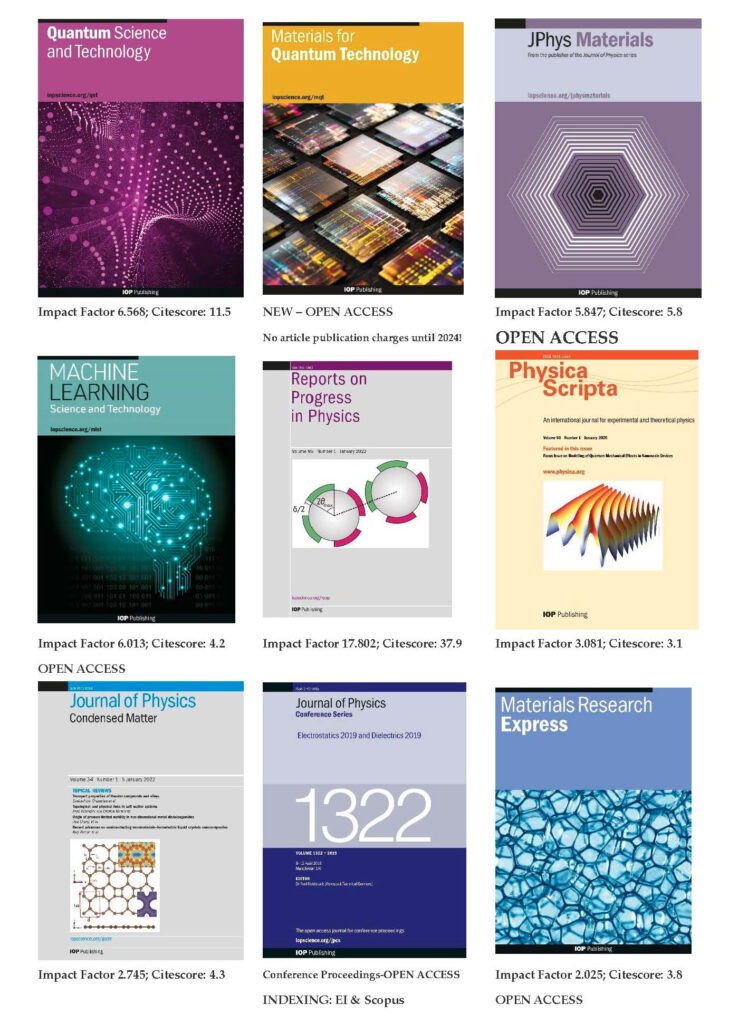开放注册|IOP出版社-南方科技大学国际研讨会:聚焦量子材料
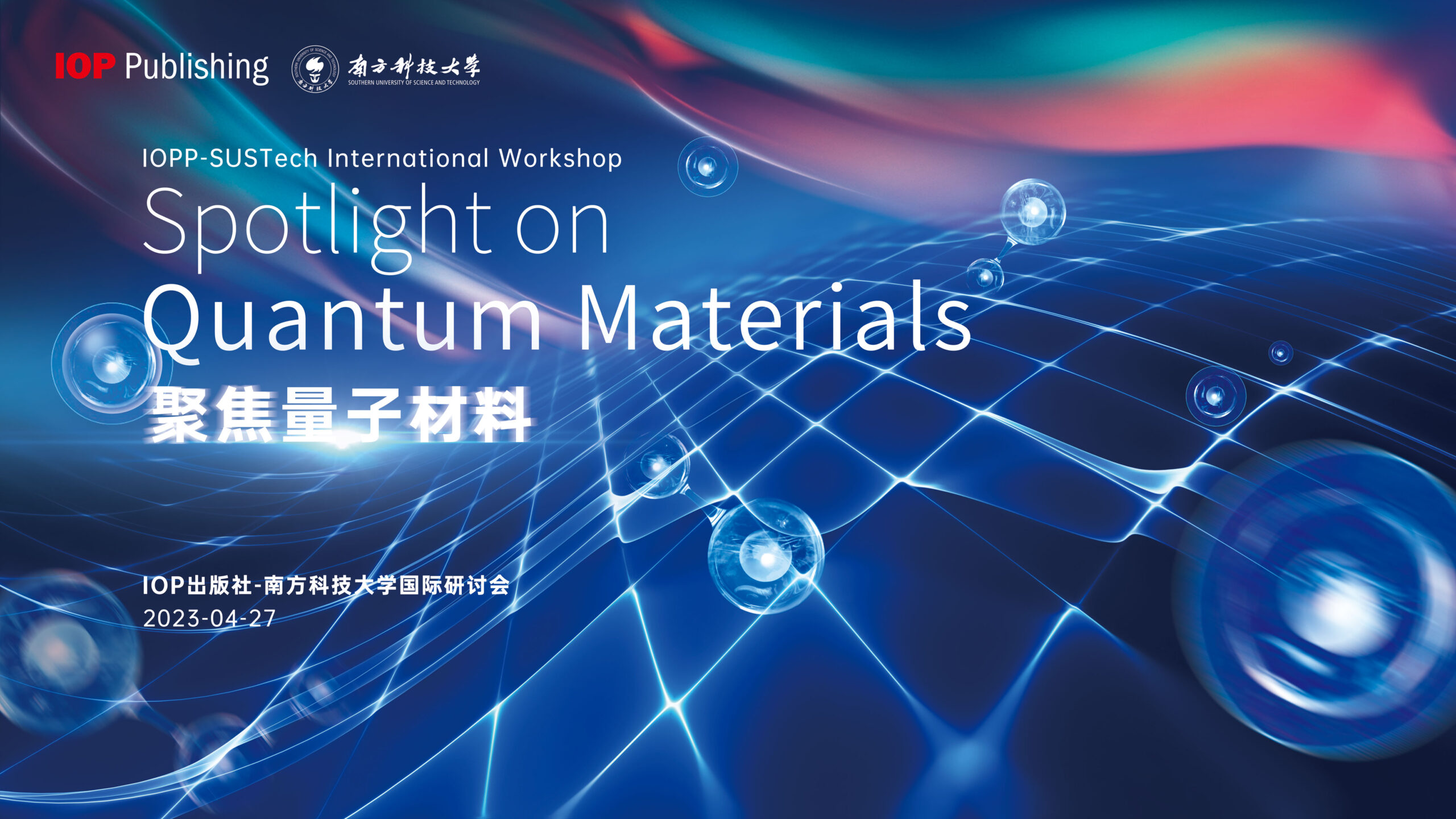
- 时间:2023年4月27日,周四
- 地点:深圳
- 形式:现场会议+视频参会
- Time: April 27, 2023
- Place:Shenzhen, China
- Form: Both online and in Shenzhen, China
由IOP出版社和南方科技大学联合主办的“IOP出版社-南方科技大学国际研讨会: 聚焦量子材料”将于2023年4月27日举办。本次研讨会汇集了来自国际的早期职业生涯学者和领军学者,分享和学习关于量子材料的前沿研究。
Co-organised by IOP Publishing and Southern University of Science and Technology (SUSTech), ‘IOPP-SUSTech International Workshop: Spotlight on Quantum Materials’ will be an international one-day workshop taking place on 27 April 2023 that brings together early career and leading researchers from the international community to share, learn and collaborate on the latest cutting-edge research on quantum materials.
会议组织委员会/Organising Committee
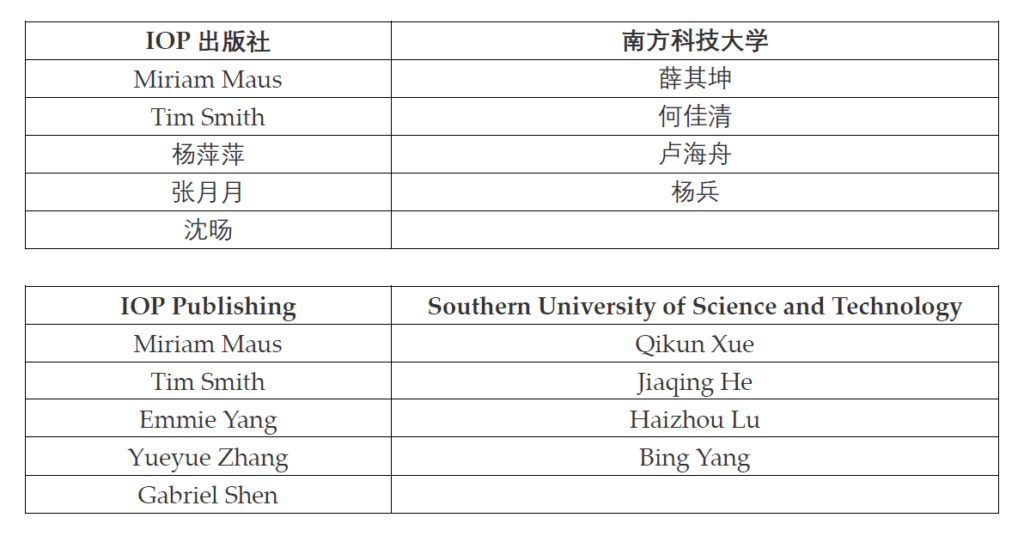
会务/Conference Service
- 联系人/Contacts:刘晓烨(Xiaoye Liu),黄绮梦(Qimeng Huang)
- 联系方式/Contact details:0755-88018258,huangqm2020@sustech.edu.cn
研讨会详情/Agenda
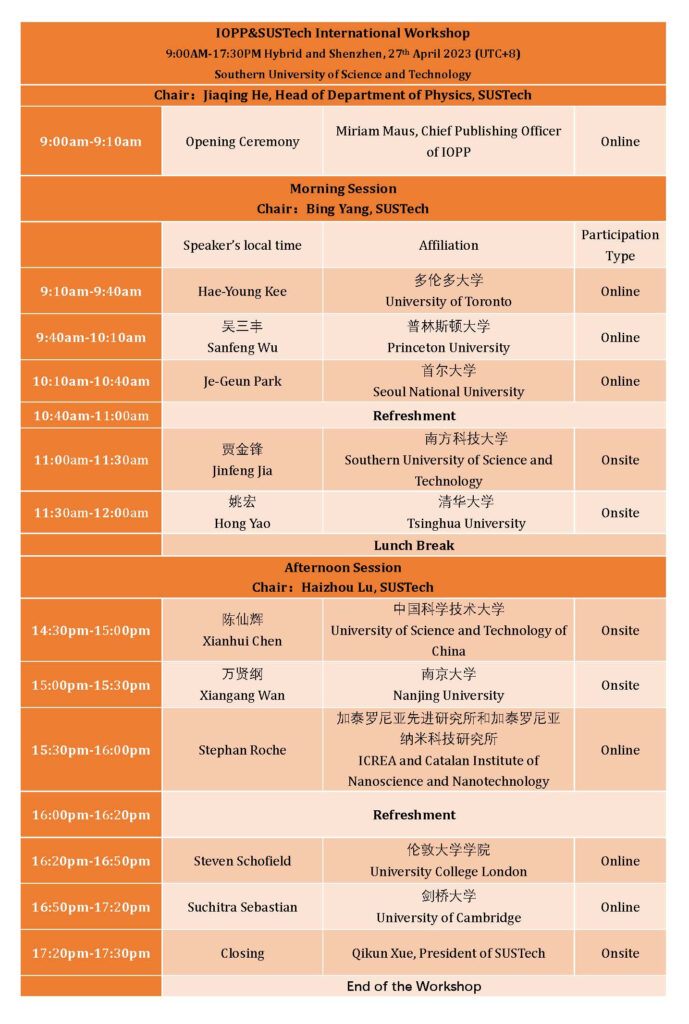
* 讲座时间以最终通知为准
* The agenda is subject to final notice.
参会方式/Registration

- 会议全部日程将会陆续更新,请大家持续关注。
- 会议注册的截止日期为2023年4月24日。
- 本次在线研讨会使用Zoom平台,首次观看前需要安装插件,建议您提前下载并安装插件。
- 另外,您也可以在蔻享观看会议转播及视频回放:https://www.koushare.com/lives/room/590073
- The full programme of sessions will be announced in the near future.
- Deadline for registration is April 24, 2023.
- This webinar will use Zoom. You need to install the plug-in before viewing it for the first time. It is recommended that you download and install the plug-in in advance.
- In addition, you can also watch the conference broadcast and video playback at KouShare: https://www.koushare.com/lives/room/590073
研讨会嘉宾/Invited Speakers

Xianhui Chen (陈仙辉)
University of Science and Technology of China (中国科学技术大学), CAS Fellow (中国科学院院士)
- Professor Xianhui Chen obtained his PhD degree at University of Science and Technology of China (USTC) in 1992. Now he is a professor at USTC, an academician of the Chinese Academy of Sciences, and a Fellow of the World Academy of Sciences. He has been a Humboldt Scholar at the Karlsruhe Research Center in Germany and the Max Planck Institute for Solid State Physics in Stuttgart, a visiting professor at the Japanese National Institute of Advanced Studies (Hokuriku), Texas Superconductivity Research Center at the University of Houston, and the National University of Singapore. He yielded the National Outstanding Youth Fund in 1998 and was appointed as a “Yangtze River Scholar” Distinguished Professor by the Ministry of Education of China in 2002. His main research interests focus on exploration of novel functional materials and the physics therein, such as superconductors, strong correlated electronic materials and topological quantum materials. Professor Xianhui Chen has published more than 470 SCI papers, including Nature(8 papers), Science(2),Nature serie- journals(24) and Physical Review Letters(41). He was awarded the Cheung Kong Scholar Achievement Award granted by the Ministry of Education and the Li Ka-shing Foundation in 2008, the Group Award for Outstanding Achievement in Science and Technology granted by the Qiushi Technology and Science Foundation in 2009, the First Prize of National Natural Science Award in 2013, the Bernd T. Matthias Prize in International Superconducting Materials in 2015, the National Innovation and Progress Medal, the Ho Leung Ho Lee Prize for Scientific and Technological progress in 2017, and the TWAS Prize in Physics in 2019.
- 报告题目/Talk Title:Topology and exotic electronic phases in two-dimensional kagome superconductor CsV3Sb5
- 报告摘要/Abstract:Kagome compounds provide a fertile playground to explore the rich interplay between geometry, topology and electronic correlations. In this talk, we focus on a topological two-dimensional kagome metal CsV3Sb5 which exhibits cascade of symmetry-breaking electronic phases, including charge density wave, electronic nematicity and superconductivity. A giant anomalous Hall conductivity is observed exactly following the CDW transition, and the superconductivity shows an unusual competition with this CDW state under pressure. Deeply in the CDW state, we found the emergence of electronic nematicity that intertwines with CDW and superconductivity. A new CDW phase induced by pressure, evolving from the electronic nematicity in ambient-pressure triple-Q CDW state, is observed. Meantime, we perform soft point-contact spectroscopy (SPCS) measurements and find that the superconducting gap is significantly enhanced between the two SC domes, suggesting strong Cooper pair phase fluctuations. At low temperatures, the topological surface states cooperate with superconductivity, and Majorana zero modes can be realized inside the vortex cores. Our results point to the essential role of charge degree of freedom in the development of intertwining electronic orders, thus provides new constraints for theories. All these results establish CsV3Sb5 as an ideal playground to study the topology and correlation driven exotic electronic orders.

Jinfeng Jia (贾金锋)
Southern University of Science and Technology (南方科技大学), CAS Fellow (中国科学院院士)
- Jinfeng Jia is a chair professor and the vice dean of the school of physics and astronomy, Shanghai Jiao Tong University/acting vice president of Southern University of Science and Technology. He graduated from Peking University in 1987. He received his Ph.D in condensed matter physics from the same university in 1992. From 1995 to 1996, he worked as a JSPS post-doc at Institute for Materials Research, Tohoku University, Japan. From 1996 to 2001, he worked as an associated professor at Department of Physics, Peking University. During the time, he worked as a visiting scientist inUSAfor 3 years. In 2001, he received the “100 Talents Project” of Chinese Academy of Sciences (CAS) and became a professor at Institute of Physics, CAS. From 2006 to 2009, he worked as a professor at Department of Physics, Tsinghua University. In 2009, he became a Cheung Kong Professor at Dept. of Physics, Shanghai Jiaotong University. He is a condensed matter experimenter. His main research interests include topological superconductors and new quantum materials, quantum phenomenon in low-dimensional nano-structures, thin film growth by molecular beam epitaxy. He authored more than 310 SCI papers, including 5 in Science, 3 in Nature Phys., 3 in Nature Materials, 2 in PNAS, 6 in Adv. Mater., 4 in Nano Letters, 30 in Physical Review Letters, with a citation of more than 18000 times. He was selected as a highly cited researcher by Clarivate Analytics from 2018 to 2021. He received a number of recognitions, including the Scientific and Technological Progress Award of Chinese State Education Commission (first class, 1997), Chinese National Natural Science Funds for Distinguished Young Scholar (2003), Prize for Advancement in Science and Technology of Beijing (first class, 2003), National Prize for Advancement in Natural Science (second class, 2004), Outstanding Science and Technology Achievement Prize of CAS (2005), National Prize for Advancement in Natural Science (second class, 2011), Group Award for Outstanding Science and Technology Achievement from Qiu Shi Science & Technologies Foundation of Hong Kong, 2011 and Achievement in Asia Award (AAA) (Robert T. Poe Prize) by the International Organization of Chinese Physicists and Astronomers (OCPA, 2013), Prize for Advancement in Natural Science of Chinese Ministry of Education (First class, 2016) and the Special Prize for Advancement in Natural Science of Chinese Ministry of Education (2017), National Prize for Advancement in Natural Science (second class, 2019).
- 报告题目/Talk Title:New progresses in topological superconductors by proximity effects
- 报告摘要/Abstract:Topological superconductors attract lots of attentions recently, since they are predicted to host Majorana zero modes (MZMs), which can be used in fault-tolerant quantum computation relying on their non-Abelian braiding statistics. Currently, most topological superconductors are artificially engineered based on a normal superconductor and the exotic properties of the electronic surface states of a topological insulator. Here, I will show you that the Bi2Te3/NbSe2 hetero-structure is an ideal artificial topological superconductor. By using spin-polarized scanning tunneling microscopy/spectroscopy (STM/STS), we observed the spin dependent tunneling effect, which is a direct evidence for the spin selective Andreev reflection from MZMs, and fully supported by theoretical analyses. Recently, the segmented Fermi surface induced by the Cooper pair momentum was observed in a Bi2Te3/NbSe2 system. It’s found that the shape and size of this Fermi surface can be adjusted by the direction and magnitude of the magnetic field, and can also modulate the topology to build new topological superconductors. This work opens up a new method to manipulate the property of crystals. Finally, the strong proximity effect was found in SnTe-Pb heterostructure. The bulk pairing gap and multiple in-gap states induced by topological surface states can be clearly distinguished. The superconductivity of SnTe is consistent with a new type of topological superconductors under the protection of lattice symmetries. Under lattice-symmetry protection, the superconducting SnTe is predicted to possess multiple MZMs in a single vortex. This system provides a platform to study the coupling of multiple MZMs without the need of real space movement of a vortex.

Hae-Young Kee
University of Toronto (加拿大多伦多大学)
- Hae-Young Kee is a professor of Physics at the University of Toronto, a Canada Research Chair in Theory of Quantum Materials, and a fellow of the Canadian Institute for Advanced Research in Quantum Materials. Kee is a theoretical physicist who specializes in condensed matter physics of complex quantum materials including quantum spin liquids, topological phases, high temperature superconductors, and frustrated magnets.
- 报告题目/Talk Title:Microscopic World of Quantum Materials
- 报告摘要/Abstract:Quantum materials provide a fertile ground for investigating exotic phenomena such as topological insulators, unconventional magnetic orders and superconductors, and spin liquids. These diverse and intricate electronic states necessitate a concept of emergence that goes beyond the traditional picture of individual electrons carrying charge, orbit, and spin. In this talk, I will present the usage of effective Hamiltonians from the microscopic degrees of freedom of target materials, with particular emphasis on low-energy spin models in Mott insulators. I will also discuss a systematic approach for identifying candidate materials with the desired Hamiltonian that underlies their emergent electronic properties and offers avenue to discover new materials.
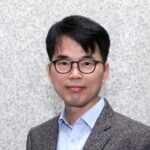
Je-Geun Park
Seoul National University (韩国首尔大学)
- Je-Geun Park is currently leading a research center focused on quantum materials supported by the Korean National Research Foundation and the Samsung Science and Technology Foundation. His group has made several world-first reports in the area of strongly correlated electron systems, in particular magnetism and neutron/x-ray scattering. The latest example is the discovery of van der Waals magnets: in 2016, his group, for the first time, succeeded in realising true two-dimensional magnetism using naturally occurring materials. He has been actively involved in several national and international academic activities. He was the founding chair of the Division of Condensed Matter Physics, the Association of the Asia-Pacific Physical Societies. He has been a core member of several international conferences: APCTP-Quantum Materials Symposium (2014-present); the Korea-Japan-Taiwan Symposium on Strongly Correlated Electron Systems (2000-present); International Conference on Strongly Correlated Electron Systems (SCES). He is the conference chair of the SCES2023, which will be held in July in Korea.
- 报告题目/Talk Title:Topology in van der Waals antiferromagnets
- 报告摘要/Abstract:Two-dimensional (2d) magnetism has been central to decades-long research as it offers the cleanest test bed for new ideas and physics. The prime example is the Berezinskii–Kosterlitz–Thouless transition of the XY model, which was discovered in the early 1970s. It heralds the beginning of topological physics, a new chapter in condensed matter physics. Despite the immense interest from the theoretical side, there has been relatively slow progress on the experimental side: most of which has depended on either quai-2d materials or thin films grown by a pulsed laser deposition technique. However, the discovery of van der Waals magnets in 2016 has completely transformed the field of 2d magnetism by providing natural 2d magnets that can be experimentally studied using many tools. Despite their short lifetime, van der Waals magnets have been used for excitingly interesting reports and ideas. With so many successes, the eyes now turn to new directions: exploring possible topological physics in 2d van der Waals magnets. In my talk, I will examine several cases of real examples.
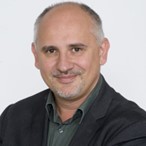
Stephan Roche
ICREA and Catalan Institute of Nanoscience and Nanotechnology(西班牙加泰罗尼亚先进研究所/西班牙加泰罗尼亚纳米科技研究所)
- ICREA Prof. Stephan Roche is working at the Catalan Institute of Nanosciences and Nanotechnology-ICN2 and BIST. He leads the “Theoretical and Computational Nanoscience” group which focuses on physics of Dirac materials (graphene & topological insulators) and 2D materials-based van der Waals heterostructures. He pioneered the development of linear scaling quantum transport approaches enabling simulations of billion atoms-scale disordered models (wwwlsquant.org). He studied Theoretical Physics at ENS and got PhD (1996) at Grenoble University (France); worked in Japan, Spain & Germany; was appointed as assistant Prof. in 2000, CEA Researcher in 2004 and joined ICREA in 2009. He received the Friedrich Wilhelm Bessel prize from the Alexander von Humboldt Foundation (Germany). Since 2013, he has been very active in the Graphene Flagship, currently as leader of the workpackage SPINTRONICS and is acting as DIVISION leader. Finally, he is leader and coordinator of the “Quantum Communications” activities at ICN2.
- 报告题目/Talk Title:Topological Spin Transport in Quantum Materials & Entanglement Dynamics
- 报告摘要/Abstract:In this talk, I will present theoretical spin transport features in Quantum Materials such as MoTe2 and WTe2-based materials which have recently been the subject of great attention within the broad context of Topological Quantum Matter. By focusing on the monolayer limit, using DFT-derived tight-binding models and using both efficient bulk and multi-terminal formalisms and techniques, I will first discuss the emergence of new forms of intrinsic spin Hall effect (SHE) that produce large and robust in-plane spin polarizations. Quantum transport calculations on realistic device geometries with disorder demonstrate large charge-to-spin interconversion efficiency with gate tunable spin Hall angle as large as θxy≈80%, and SHE figure of merit λs.θxy∼8-10 nm, largely superior to any known SHE material. Besides, I will present our theoretical prediction of an unconventional canted quantum spin Hall phase in the monolayer Td-WTe2, which exhibits hitherto unknown features in other topological materials. The low-symmetry of the structure induces a canted spin texture in the yz plane, dictating the spin polarization of topologically protected boundary states. Additionally, the spin Hall conductivity gets quantized (2e2/h) with a spin quantization axis parallel to the canting direction. Our theoretical predictions for the canted QSHE findings have just been confirmed experimentally, and we have also shown that a perpendicular electric field could tailor the canting angle, with a 90° coherent rotation. I will finally discuss the role of entanglement between intraparticle degrees of freedom in spin transport and dynamical patterns of entanglement, as enabling novel platform for generating and manipulating quantum entanglement between internal and interparticle degrees of freedom.

Steven Schofield
University College London (英国伦敦大学学院)
- Steven Schofield is an Associate Professor of Condensed Matter Physics at University College London with a joint appointment between the London Centre for Nanotechnology and the Department of Physics and Astronomy. He is interested in understanding and controlling the fundamental quantum properties of matter at the atomic scale for potential applications in classical and quantum information processing. His research group uses atomic-scale fabrication and cryogenic temperature, ultrahigh vacuum scanning tunnelling microscopy and spectroscopy to create and investigate nanostructures in semiconductor and two-dimensional materials. Often these measurements are made in conjunction with complementary techniques including momentum-resolved photoelectron spectroscopy and first-principles simulation.
- 报告题目/Talk Title:The Arsenic Advantage: Surpassing Phosphorus for Atomic-Scale Quantum Devices in Silicon and Germanium
- 报告摘要/Abstract:Atomic-scale quantum electronic devices can be fabricated via the deterministic placement of individual donor atoms in semiconductors. This breakthrough technology paves the way for innovative quantum electronic components and potentially scalable architectures. At the core of this potential lies the atomically precise incorporation of dopant atoms into semiconductor surfaces, achieved by adsorbing chemical precursor molecules onto surfaces lithographically patterned using a scanning tunnelling microscope. To date, the focus in this area has been the creation of devices using phosphorus in silicon; however, recent work suggests this may not be the ideal material system for atomic-scale quantum devices. In this talk, I will present a brief overview of this rapidly developing field, including our recent results for the incorporation of arsenic atoms into silicon and germanium and reasons why arsenic may soon replace phosphorus as the dopant of choice for atomic-scale semiconductor quantum electronics.

Suchitra Sebastian
University of Cambridge(英国剑桥大学)
- Suchitra Sebastian is Professor in Physics and EPSRC Established Career Fellow at the University of Cambridge. Her research seeks to discover exotic quantum phases of matter in complex materials. To this end, her group’s experiments involve tuning the co-operative behaviour of electrons within these materials by subjecting them to extreme conditions including low temperature, high applied pressure, and intense magnetic field. Under these conditions, interactions between a trillion trillion electrons, as many as the stars in the observable universe, create surprising and unpredictable collective quantum phases akin to new materials ‘universes’. Emergent quantum phenomena studied by Suchitra’s research group include high-temperature superconductivity and a new unconventional insulating state of matter they recently discovered. Most recent awards Suchitra has received include the New Horizons in Physics Prize (2022) awarded by the Breakthrough Foundation and the Schmidt Science Polymath award (2022). Suchitra is founder director of the Cavendish Arts Science programme, and co-founder of Bread Theatre and Film Company. She participates in scientific research for non-imperialistic, non-militaristic purposes.
- 报告题目/Talk Title:Quantum oscillations hosted by unconventional pseudogap state in the underdoped cuprate superconductors
- 报告摘要/Abstract:The underdoped cuprate superconductors host a breadth of intriguing behaviours. High temperature superconductivity, the mysterious pseudogap phenomenon and charge density wave order all interplay with each other in the underdoped regime of the cuprates. The observation of quantum oscillations with Fermi Dirac statistics in this mysterious regime presents a conundrum. We discuss the nature of the unconventional pseudogap state that we find to host quantum oscillations while remaining superconducting up to high magnetic fields.
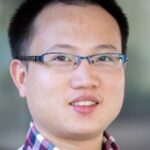
Sanfeng Wu(吴三丰)
Princeton University(美国普林斯顿大学)
- Sanfeng Wu is an assistant Professor of Physics at Princeton since 2019. Before Princeton, he was a Pappalardo Fellow in Physics at MIT. He received his undergraduate degree at the University of Science and Technology of China in 2010 and his Ph.D. in physics at the University of Washington, Seattle in 2016.
- 报告题目/Talk Title:Topology, Superconductivity and Unconventional Quantum Criticality in Monolayer WTe2
- 报告摘要/Abstract:Quantum critical points associated with quantum phase transitions are highly intriguing states of matter; yet they are difficult to study. An example is the superconductor to insulator or metal transition in two dimensions (2D), a topic that has a long history in condensed matter research, but many problems remain unsolved. In this talk, I will discuss our recent experimental finding of a quantum critical point in monolayer tungsten ditelluride (WTe2), a unique 2D crystal in which topology, strong correlations and superconductivity all occur in a single material. We directly measure superconducting quantum fluctuations, whose behaviors are so anomalous that they call for an unusual explanation beyond the conventional Landau-Ginzburg-Wilson paradigm.
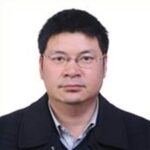
Xiangang Wan (万贤纲)
Nanjing University (南京大学)
- Professor Xiangang Wan obtains Ph.D from Nanjing University, China at 2000. After four years Post-doctor at National Institute for Material at Japan and U.C. Davis at US, he back to Nanjing University as Assistant Professor, Associate Professor, and become full Professor at 2010. He had been selected as The Chinese National Science Fund for Distinguished Young Scholars at 2015. He had been awarded the Ye Qisun Prize for Physics at 2019. He had also obtained the XPLORER PRIZE from Tencent Foundation at 2019.
- 报告题目/Talk Title:Novel three-dimensional Fermi surface and electron-correlation-induced charge density wave in FeGe
- 报告摘要/Abstract:As the first magnetic kagome material to exhibit the charge density wave (CDW) order, FeGe has attracted much attention in recent studies. All the theoretically calculated phonon frequencies in FeGe remain positive. We perform a comprehensive study through first-principles calculations and symmetry analysis. We find that reasonable Heisenberg interactions and magnetic anisotropy cannot explain the double cone magnetic transition, and the DM interactions can result in this small magnetic cone angle. Based on the experimental 2X2X2 supercell, we thus explore the subgroups of the parent phase. Group theoretical analysis reveals that there are 68 different distortions, and only four of them without inversion and mirror symmetry thus can explain the low temperature magnetic structure. We also find that the maximum of nesting function is at K point instead of M point. Considering the effect of local Coulomb interaction, we reveal that the Fermi level eigenstates nested by vector K are mainly distributed from unequal sublattice occupancy, thus the instability at K point is significantly suppressed. Meanwhile, the wave functions nested by vector M have many ingredients located at the same Fe site, thus the instability at M point is enhanced. This indicates that the electron correlation, rather than electron-phonon interaction, plays a key role in the CDW transition at M point.
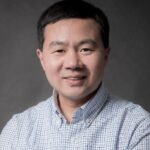
Hong Yao (姚宏)
Tsinghua University (清华大学)
- Hong Yao is currently a professor at Tsinghua University and an APS Fellow. He received his Ph.D. degree from Stanford University in 2009. In 2009-2012, he did his postdoctoral research first in University of California at Berkeley and then in Stanford University. He joined the Institute for Advanced Study at Tsinghua University in 2012 and became a full professor there in 2017. Prof. Yao has made fundamental contributions to the theory of quantum phases of matter, novel quantum critical phenomena, and their realization in quantum materials (citation of APS Fellow). He has published more than 110 papers, including 2 in Science, 4 in Nature Physics, and 30 in PRL, with more than 9800 citations (Google Scholar). Prof. Yao was awarded the National Science Fund for Distinguished Young Scholars in 2018, the Daniel Tsui Fellowship by the University of Hong Kong in 2021, and the Ye Qisun Prize by the Chinese Physical Society in 2022.
- 报告题目/Talk Title:Pair-density-wave and high-temperature superconductivity: the role of electron-phonon coupling
- 报告摘要/Abstract:Electron-phonon coupling (EPC) and electron-electron interaction are ubiquitous and typically strong in strongly-correlated quantum materials. Moreover, increasing studies have reported evidences that EPC could be crucial in understanding various quantum phases of matter such as Fe-based and cuprate high-temperature superconductivity. In this talk, I will show that EPC, often in collaboration with electron-electron interactions, could play an important (sometimes dominant) role in inducing exotic quantum phases of matter such as pair-density-wave superconductivity, antiferromagnetic long-range order, and d-wave superconductivity. Our results might shed new light to understanding the role of EPC in strongly-correlated quantum materials.
支持期刊/Supporting Journals and Database
